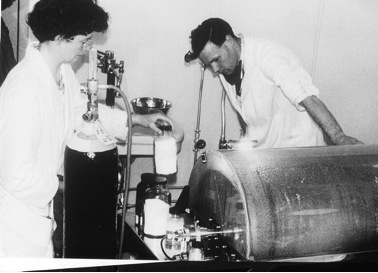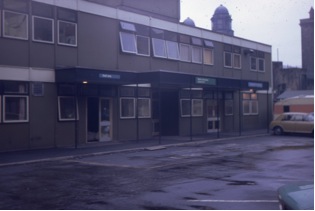Glasgow
By Dr. Marjorie Allison and John Hopewell. From John Hopewell’s collection of Renal Unit histories.
The University of Glasgow page on the history of renal services in Glasgow and the West of Scotland is excellent also.
An early special interest in renal medicine had been shown in Glasgow where the world’s first (open) kidney biopsies were performed on nephrotic children, an account of which was published by Campbell in 1930. Campbell,G. 1930 Arch Dis Child 5:283-290.
In the UK the first regional referral unit for children with renal disease was established at the Royal Hospital for Sick Children in Glasgow in 1950 by Dr (later Prof.) Gavin Arneil, together with consultant pathologist Dr. A.M. Macdonald and a research fellow, Dr Studzinski. In the following decade the unit published some 16 papers reporting the first series of children in Europe, with nephrotic syndrome treated with various corticosteroids, culminating in the review by Arneil in 1961, of no less than 164 children with “nephrosis”, which also highlighted retrospectively the dramatic reduction( not production !) of mortality brought about by the introduction of sulphonamides and penicillin during the late 1940s. In the 1960s peritoneal dialysis was pioneered in the unit in the treatment of acute renal failure, and led to its later use in the management of end-stage renal failure.
Prof Arneil published 143 valuable papers in his specialty between 1946 and 1983. In 1967 he became the co-founder and first president of the European Society for Paediatric Nephrology, and founder and first secretary-general of the International Pediatric Nephrology Association. The British Association of Paediatric Nephrology was founded in 1973, and the account above is abstracted from the history of its first 30 years by its past president and honorary archivist, Dr. Richard H.R. White.
The adult renal unit in Glasgow Royal Infirmary began in the late 1950s, thanks to the work of two men – Arthur Jacobs (1899-1974), Consultant Urologist and Arthur C. Kennedy,(1923 – 2009) Senior Lecturer and later Professor of Medicine.
We are fortunate in having access to a recorded interview with Professor Kennedy, made in 1986, in which he details the various trials, tribulations and success stories of these early years. The recording was made by Dr Peter Mackenzie, Retired Consultant Physician, a man to whom a large debt is owed for preserving the oral history of the eminent medical and surgical men and women from Glasgow in the mid 20th Century. A transcript of this recording can be read below. The following is a short summary:

Professor A.C. Kennedy, 1993.
This renal unit began almost by chance. In 1957 Dr Kennedy had been appointed senior lecturer in the Professorial Medical Unit of Glasgow Royal Infirmary under Professor Leslie Davies. ( Leslie and Lesley!) Dr Kennedy, searching around for a new specialty realized that adult renal disease was not being pursued in Glasgow by any of his colleagues. By chance Arthur Jacobs , Consultant in charge of the Urology Department , was very anxious for a dialysis unit to be set up. He had the necessary resources to buy an artificial kidney, the money having been donated by a grateful patient. He was looking for a young man to undertake the development work.
As a result Arthur Kennedy went to Leeds to learn about the handling of the rotating drum kidney from Frank Parsons. A similar French Usifroid (drum-coil) artificial kidney was ordered for Glasgow. This machine was placed in the basement of the Urology Building and remained in use there until 1974. The first dialysis was performed in the early summer of 1959 on a lady with drug induced (probably sulphonamide) acute renal failure, whose condition improved, but who sadly did not survive.
We are fortunate in having an account of these very early dialyses:-

The first haemodialysis in Glasgow Royal Infirmary, 1959.
Memoir and Photographs by M G H Smith, FRCS.
In 1959, I was a surgical registrar in the Glasgow Royal Infirmary, and was in a year of rotation through various specialties and during the months of May, June, and July was working in the Urology department. I cannot give you an exact date for these photographs but I am certain the ‘artificial kidney’ didn’t arrive until early June.
The circumstances of its delivery might have destroyed the machine as it was crated up and was very heavy. The SHO, Adam Fleck, who witnessed the machine being delivered, told me about this later as I was in theatre or doing an IVP list at the time. A squad of GRI porters discovered the weight of this and clearly felt the easiest way to get this from the lorry into the Urology building would be by turning it end over end and had paced out the distance for that, all of this despite the warning notices all over the crate saying ‘This way up’, and the ‘umbrella’ and ‘wine glass’ signs for those who might not understand the language! Fortunately the crate was delivered safely in due course.
During the remainder of my stay in Urology, five patients were referred for dialysis carried out by Arthur Kennedy, and I was involved in all of these as the ‘surgical plumber’ to put in the cannulations under LA of radial artery and a vein. and then to join the small team of ACK, a biochemist, often the SHO, and sometimes a nurse. The referrals were ‘phoned in from the ‘Elsewhere General’, usually in an afternoon and by the time the patient arrived, had fresh biochemistry done, blood grouped and cross matched, the dialysis session never started before the evening and ran through the night. The preparation was always done by ACK, with the unskilled assistance of the rest of us, and we took it in turn to watch over the patient who was usually sleeping. while the rest of the team tried to get a meal or a short sleep. I found when I was with the patient, tired and listening to the soporific swishing sound of the dialysis machine, that I would fall asleep and took to sitting up on a stool with no back so that if/when I fell asleep, I would wake upon hitting the floor!
Again I cannot give a date for the dialysis shown in these pictures, other than late June or July 1959. I do recall this patient, a woman, was probably the third case dealt with as this was marked by a better blood flow and a better result in the fall of the blood urea.
At the time, the cannulations were done with a plastic tube heated and drawn out into a taper so that one could cut this off at whatever size seemed appropriate for the artery or vein, and it seemed to me that the thickness of the plastic tube wall made the lumen rather small and I mentioned this to ACK who agreed that having the actual cannulation into the vessel by a thin walled metal tube would be helpful, but I was to leave Urology before any change took place.
In the print ( above) showing ACK and the lady biochemist, she is holding a bottle filled with some white substance. I think this will have been made up by the biochemist with whatever chemicals were needed on changing the ‘bath water’ once or twice in each session of dialysis.
In those early years Arthur Kennedy was in charge of all the dialysis himself – and he makes the wry comment that patients were invariably referred to him on Friday evening, so taking him away from his family for the whole of the weekend – an observation made by many others in those pioneering days. Experience grew, chiefly from treating acute renal failure as a result of septic abortion and of accidents, until he was able to achieve a survival rate of 50% and better than this in the younger, fitter cases. (Kennedy, A.C., Gray, M.J.B., .Dinwoodie, A.J. and Linton, A.L.(1961) Removal of urea ,creatinine, uric acid and inorganic phosphate by a rotating-drum artificial kidney. Lancet ii 996) He and his young team were early to work out the cause of confusion developing under rapid dialysis, realizing its cause was a due to a disequilibrium of urea across the blood-brain barrier. He further recounts how, at an international conference, he had a disagreement with John Merrill, who could not accept the idea. ( Kennedy,A.C., Linton, A.L., Luke, R.G., Renfrew, S.. and Dinwoodie, A.(1964). The pathogenesis and prevention of cerebral dysfunction during dialysis. Lancet i 790)
In 1962 he was awarded a traveling fellowship that allowed him to visit renal units in the U.S.A. This included one to Scribner in Seattle, where he came across the first four patients with chronic renal failure being maintained on regular dialysis. On his return to Glasgow he acquired a Twin Coil artificial kidney and made a start in 1964 on maintenance dialysis. He was one of those attending the meeting called by the Chief Medical Officer, George Godber, where it was announced that his department would make funds available for maintenance dialysis. Glasgow Royal Infirmary benefitted by the acquisition of a dedicated building for the purpose, which cost £30,000 but also included all the Haematology Laboratories !

The first regular dialysis unit in Glasgow , 1966 on ground floor and Blood transfusion above.
He was one of the first to learn the technique of renal biopsy, which led to a deep interest in the early stages of renal disease on which he was an authority and wrote many papers on the subject.
The unit has grown steadily with the general advances in nephrology. In 1993 the European Dialysis and Transplant Association met in Glasgow. Professor Kennedy was able to explain Glasgow’s significant role in the development of dialysis, from the pioneering work of Professor Thomas Graham in the 1860s to the practical application of dialysis in the treatment of renal failure one hundred years later.

Glasgow. E.D.T.A. 1993.
Professor Kennedy and Princess Anne.
Last Updated on July 30, 2022 by neilturn